
Saccharum is a genus of tall perennial plants of the broomsedge tribe within the grass family.

Thelesperma filifolium, commonly known as stiff greenthread, or plains greenthread, is a species of flowering plant in the aster family, Asteraceae. It is often found growing in shallow soils. It prefers disturbed sites in dry, sandy or gravelly soil with a neutral to basic pH. Stiff greenthread adapts to various soil conditions, including loam, clay, caliche, and roadsides. It blooms between March and June and often into the fall.

Dracophyllum is a genus of plants belonging to the family Ericaceae, formerly Epacridaceae. There are 61 species in the genus, mostly shrubs, but also cushion plants and trees, found in New Zealand, Australia, Lord Howe Island and New Caledonia. The name Dracophyllum, meaning dragon-leaf, refers to their strong outward similarity to the unrelated Dracaena, sometimes known as dragon tree. Although dicotyledonous, they resemble primitive monocots with their slender leaves concentrated in clumps at the ends of the branches; they are sometimes called grass-trees.

Conospermum is a genus of about 50 species in the family Proteaceae that are endemic to Australia. Members of the genus are known as smokebushes - from a distance, their wispy heads of blue or grey flowers resemble puffs of smoke. They have an unusual pollination method that sometimes leads to the death of visiting insects. They are found in all Australian states, though most occur only in Western Australia. Smokebushes are rarely cultivated, though the flowers of several Western Australian species are harvested for the cut flower industry.
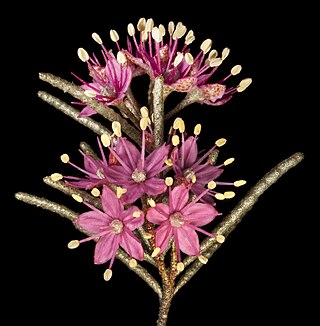
Phebalium is a genus of thirty species of shrubs or small trees in the family Rutaceae and is endemic to Australia. The leaves are arranged alternately, simple and often warty, the flowers arranged singly or in umbels on the ends of branchlets or in leaf axils, usually with five sepals, five petals and ten stamens. There are about thirty species and they are found in all Australian states but not in the Northern Territory.
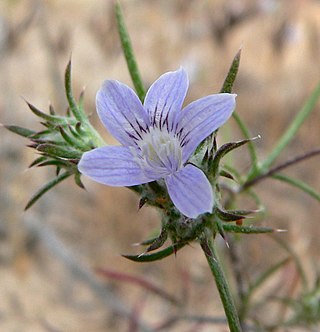
Eriastrum is a genus of flowering plants in the phlox family which are known commonly as woollystars. These wildflowers are somewhat diverse in appearance but are usually erect, thin-stemmed herbs which bear purple to white blooms. Most species have inflorescences which are webbed with a woolly mesh of white fibers. Woollystars are native to western North America.
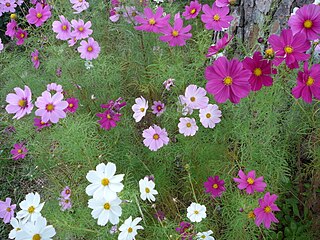
Coreopsideae is a tribe of flowering plants belonging to the Asteroideae subfamily. It includes widely cultivated genera such as Cosmos and Dahlia.
Filifolium is a genus of flowering plants in the daisy family.

Axillarin is an O-methylated flavonol. It can be found in Pulicaria crispa, Filifolium sibiricum, Inula britannica, Wyethia bolanderi in Balsamorhiza macrophylla and in Tanacetum vulgare. It can also be synthetized.
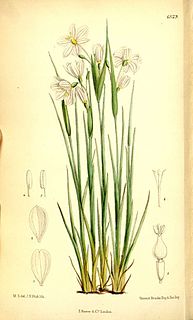
Olsynium filifolium , or Bermudiana filifolia, is the only species of the iris family native to the Falkland Islands. It is much better known by its former name Sisyrinchium filifolium. Although it is no longer as common as it once was, it is widely distributed on the islands, and favours temperate dwarf shrub heath. It is also found in Patagonia.

Galium obtusum, the bluntleaf bedstraw, is an herbaceous plant species in the family Rubiaceae. Bluntleaf bedstraw is a wildflower native to eastern North America.
Pseudopogonatherum is a genus of Asian and Australian plants in the grass family.

Erigeron filifolius is a North American species of flowering plants in the family Asteraceae known by the common names thread-leaf fleabane.

Acacia filifolia is a shrub belonging to the genus Acacia and the subgenus Juliflorae that is endemic to western Australia.

Acacia auratiflora, commonly known as the orange-flowered wattle, is a shrub of the genus Acacia and the subgenus Plurinerves. It is listed as an endangered species.
Conospermum filifolium is a shrub endemic to Western Australia.
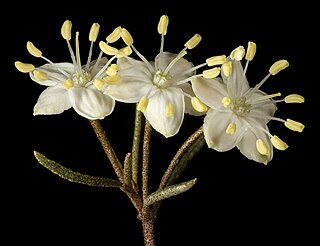
Phebalium filifolium, commonly known as slender phebalium, is a species of upright, rounded shrub that is endemic to Western Australia. It has smooth branchlets covered with silvery scales, more or less cylindrical leaves with silvery scales on the lower side and pale to bright yellow flowers arranged in umbels of between three and eight on the ends of branchlets.

Stenopetalum is a genus in the Brassicaceae family which is endemic to Australia. It was first described by Robert Brown in 1821.
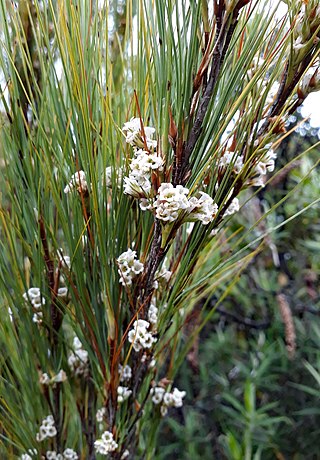
Dracophyllum filifolium is a species of shrub or tree endemic to the North, South, and Stewart Islands of New Zealand. It was first described by Joseph Dalton Hooker in 1853 and gets the specific epithet filifolium for its leaves being like a filament. In the heath family Ericaceae, it inhabits mountain slopes, saddles and ridges and reaches a height of 1–4 m (3–13 ft). A 2017 assessment using the New Zealand Threat Classification System classified it as “Not Threatened,” giving it an estimated population of more than 100,000.

Schoenia filifolia is a species of flowering plant in the family Asteraceae, and is endemic to the southwest of Western Australia. It is an annual herb with terete leaves and yellow, daisy-like inflorescences.
















